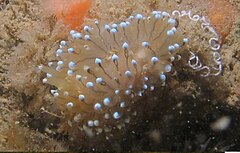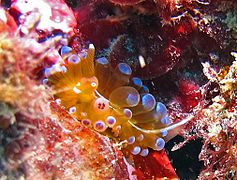
Nudibranchs are a group of soft-bodied, marine gastropod molluscs which shed their shells after their larval stage. They are noted for their often extraordinary colours and striking forms, and they have been given colourful nicknames to match, such as "clown," "marigold," "splendid," "dancer," "dragon," or "sea rabbit." Currently, about 3,000 valid species of nudibranchs are known.
Janolus is a genus of small to large sea slugs, or more accurately nudibranchs, marine gastropod mollusks, in the family Proctonotidae. The name Janolus is derived from the two-headed god Janus, in ancient Roman mythology.

Metarminoidea is a provisional taxonomic superfamily of colourful sea slugs, aeolid nudibranchs, marine opisthobranch gastropod molluscs in the clade Nudibranchia.
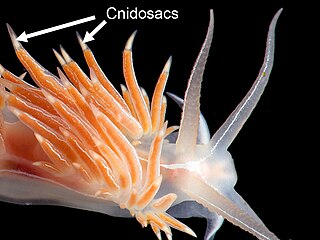
Cerata, singular ceras, are anatomical structures found externally in nudibranch sea slugs, especially in aeolid nudibranchs, marine opisthobranch gastropod mollusks in the clade Aeolidida. The word ceras comes from the Greek word "κέρας", meaning "horn", a reference to the shape of these structures.
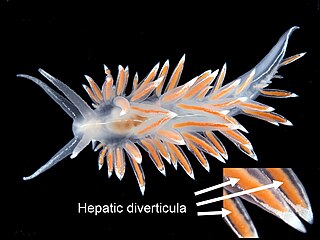
As applied to mollusks, the New Latin term diverticulum is an anatomical feature. The term is most often encountered in the plural form as "diverticula", "hepatic diverticula", or "digestive diverticula", which are anatomical terms for organs which are visible from the outside of the body in a clade of sea slugs known as aeolid nudibranchs, marine opisthobranch gastropod molluscs.

Dirona albolineata is a species of sea slug, an Eastern Pacific Ocean nudibranch, a marine, opisthobranch gastropod mollusk in the family Dironidae.

Janolus capensis, the Cape silvertip nudibranch, is a beautiful species of nudibranch, or sea slug. It is a marine gastropod mollusc in the family Proctonotidae.

Janolus longidentatus, the medallion silvertip nudibranch, is a spectacular-looking species of nudibranch, or sea slug. It is a marine gastropod mollusc in the family Proctonotidae.
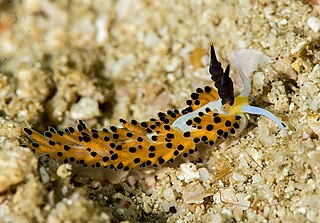
Favorinus tsuruganus is a species of aeolid nudibranch, a sea slug. It is a marine gastropod mollusk in the family Facelinidae.

Paraflabellina ischitana is a species of sea slug, an aeolid nudibranch, a marine gastropod mollusk in the family Flabellinidae.

Edmundsella pedata is a species of sea slug, an aeolid nudibranch, a marine gastropod mollusc in the family Flabellinidae.
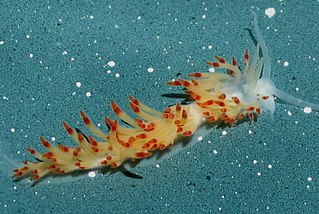
Pacifia goddardi is a species of sea slug, an aeolid nudibranch, a marine gastropod mollusc in the family Unidentiidae. This species was recently discovered by Jeff Goddard, and named by his friend, Terry Gosliner. It was found while searching for another species in Carpinteria State Beach in Santa Barbara, California.

Scyllaea pelagica, common name the sargassum nudibranch, is a species of nudibranch, a marine gastropod mollusc in the family Scyllaeidae. This species lives among floating seaweed in the world's oceans, feeding on hydroids.
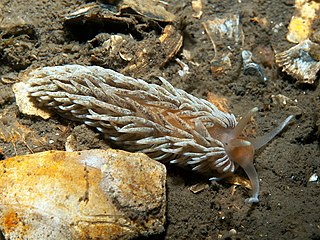
Aeolidiella glauca is a species of sea slug, an aeolid nudibranch in the family Aeolidiidae.
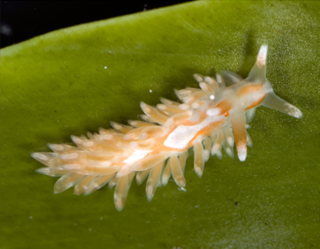
Anteaeolidiella lurana, is a species of sea slug, an aeolid nudibranch. It is a marine gastropod mollusc in the family Aeolidiidae.

Tenellia phoenix is a species of sea slug, an aeolid nudibranch, a marine gastropod mollusc in the family Fionidae.

Spurilla neapolitana, the Neapolitan spurilla, is a species of sea slug, an aeolid nudibranch, a marine gastropod mollusk in the family Aeolidiidae. It is native to the western Atlantic Ocean, the Caribbean Sea and the Mediterranean Sea. This species was first described as Eolis neapolitana by the Italian naturalist Stefano delle Chiaje in 1841. However, although some authorities quote the year as 1823, the species does not appear in the first volume of delle Chiaje's memoirs, which was published that year. The species was later reassigned to the genus Spurilla.
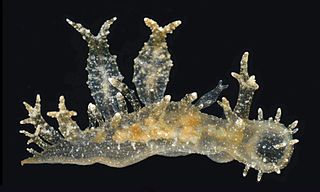
Melibe arianeae is a species of sea slug, a nudibranch, a marine gastropod mollusc in the family Tethydidae.

Janolus savinkini, common name purple-tipped janolus, is a colorful sea slug, an arminina nudibranch, a marine gastropod mollusc in the family Proctonotidae. The body and caruncle of this species are yellow with a hue of light orange. The papillae and cerata are also this colour except for the tips, which are blue/purple, hence the common name. It is found in East Asian waters and is believed to be extremely rare in Okinawa.
Janolus flavoanulatus is a sea slug species. The specific name is derived from Latin words flavus (“yellow”) and anulatus (“ringed”). These soft-bodied mollusks are known for their extraordinary colors and prominent forms. The first description of this species was reported by researcher Terry Gosliner, a leading researcher in the evolutionary history of nudibranchs. Upon his conducted research in the Philippines, Gosliner named Janolus flavoanulatus for its yellow ring around its cerata.

